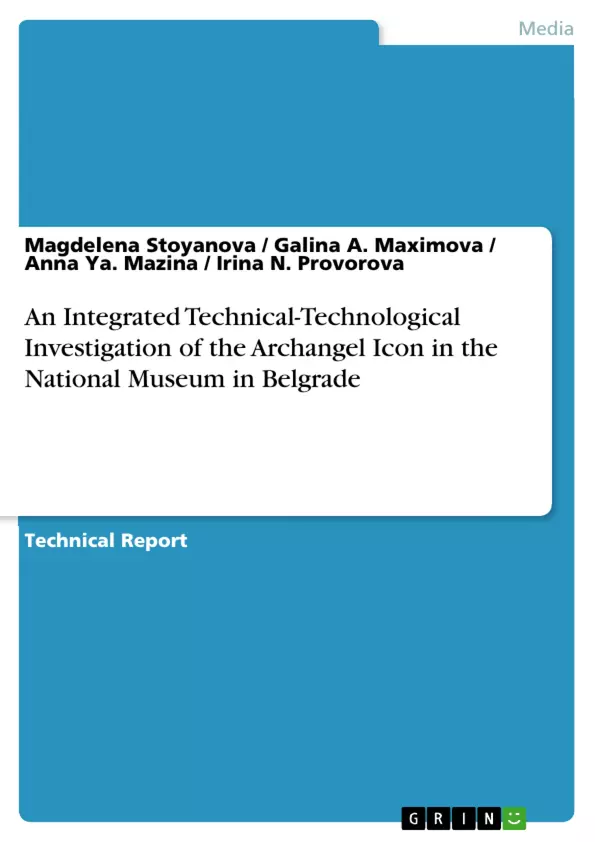This complex investigation by European and Russian experts was carried out for the purpose of solving the question of the authorship and date of the Archangel icon kept in the National Museum in Belgrade and attributed to the 15th c Novgorod school. It had also the task to explore the possibilities and limits of non-destructive methods in identification, dating and authentication of icon painting, as well as of other types of historic easel painting.
In addition to the various technological methods, the research project included assessment of the outcomes on base of additional information from databases accumulated by leading research and restoration centers in Russia and Eastern Europe.
The authors' purpose was to demonstrate that actually the conditions for authenticity controls are easily available, and that they can be realized at an enough competitively level, making better use of already accumulated experience and using a more common technological base.
Particularly important is to underline that tools for efficient non-contact investigation of artefacts are not exclusively the optical techniques and the utilized instruments for themselves, but also the way in which the various data they produce have been assessed. For to transform these informational resources in real knowledge, their mass storage and interactive art historical, technical and technological assessment is of fundamental importance.
The non-destructive methods and techniques used included optical microscopy, macro photography in VIS/raking light, stereo microscopy, ultraviolet luminescence/fluorescence, infrared reflectography, X-ray, EDXRFS, computer tomography, anatomical analysis of wood, micro chemical analysis, and were followed by a comparison and post processing of obtained data and images, allowing to date the icon at the second half of the 19th century (the earlier attribution was 15th century). The icon may have been created by icon painters of the southern regions of the Russian Empire (perhaps in Moldova or Ukraine).
The results created the conditions for a detailed mapping of its status of conservation and were indispensable for to understand the origin of the damages.
Inhaltsverzeichnis (Table of Contents)
- Chapter I
- Preface
- About the editorial staff
- Other participants in the research project
- Support and funding
- Summary
- Type of case study
- Rationale
- Descriptors
- Objectives
- Scientific Documentation
- Attribution
- Conservation and Restoration
- Exploring Possibilities and Limits of ND Methods
- Interdisciplinary Application
- Information about the cultural heritage object used in the study
- State-of-the-art
- Description of the visual record created, technologies, tools, software/hardware access information and copyright
- Methodology
- Analysis
- Standards employed; data formats and protocols
- Chapter II
- Description of outcomes and issues
- Authenticity and Dating
- Technical-Technological Analyses of Tempera, Mixed Techniques, and Oil Painting
- Opportunities for Digital Image Post-Processing and Interpretation
- Exploration of Innovative Non-Destructive Methods for Distinguishing Original from Secondary Works
- Conservation and Restoration Strategies
Zielsetzung und Themenschwerpunkte (Objectives and Key Themes)
This report, compiled in the framework of the COST Action TD1201-COSCH (2013-2017), focuses on the comprehensive technical-technological investigation of an Archangel icon from the National Museum in Belgrade, Serbia. The main objective of the study was to determine the icon's authenticity, date, authorship, and conservation status. The research project employed a range of non-destructive methods to analyze the icon's structure, materials, and painting techniques.
Zusammenfassung der Kapitel (Chapter Summaries)
Chapter I introduces the project, its goals, the team of experts involved, and the institutions that contributed to its realization. It provides a detailed overview of the methods employed, including optical microscopy, macrophotography, UV luminescence, IR reflectography, X-ray, EDXRFS, computer tomography, and wood identification. The chapter also highlights the importance of integrating various data sources and the challenges of interpreting the results of non-destructive methods.
Chapter II presents the findings of the investigation. It delves into the specific outcomes of each method, discussing the icon's construction, materials, paint layers, and the presence of later interventions. This chapter also explores the icon's stylistic ties to Old Russian icon painting and the challenges of attribution.
Schlüsselwörter (Keywords)
The primary focus of the study is on the scientific-technological analysis of the Archangel icon. The research encompasses the following areas: Russian icon painting, iconography of archangels Michael and Gabriel, attribution of icons, analytical techniques, modern technologies, non-destructive methods, archaeometry, Anobiidae beetles attack, and biodeterioration of wooden supports.
- Citation du texte
- Ph.D. Magdelena Stoyanova (Auteur), Galina A. Maximova (Auteur), Anna Ya. Mazina (Auteur), Ph.D. Irina N. Provorova (Auteur), 2016, An Integrated Technical-Technological Investigation of the Archangel Icon in the National Museum in Belgrade, Munich, GRIN Verlag, https://www.grin.com/document/358348



